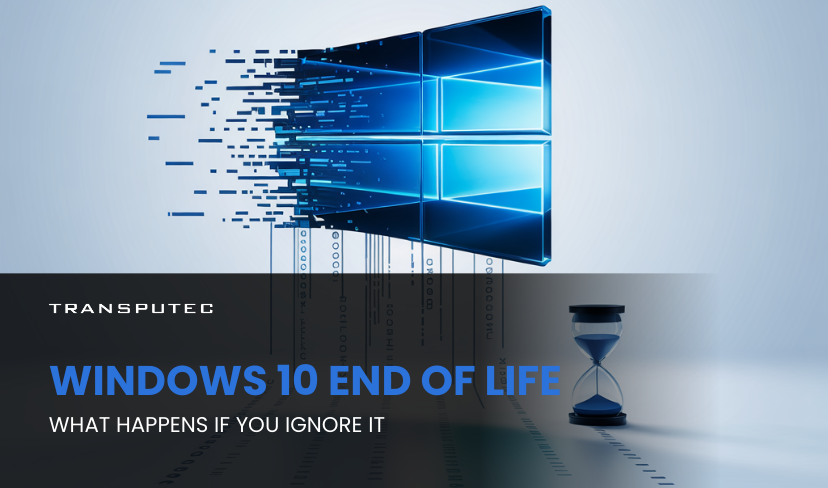Written by KRITIKA SINHA | MARKETING
When your team’s laptops suddenly freeze mid-presentation or critical systems halt due to security breaches, your business doesn’t just lose time — it loses trust. These issues often have a hidden root cause: outdated operating systems. With Windows 10 End of Life fast approaching (October 14, 2025), this seemingly distant date is now an urgent checkpoint for businesses relying on outdated infrastructure.
This blog delves deep into why ignoring Windows 10 End of Life could be a costly mistake. We’ll cover the security, compliance, operational, and financial impacts of holding on to Windows 10 after support ends. Plus, we’ll explore how proactive planning — with the support of an expert partner like Transputec — can transform this challenge into an opportunity for IT innovation and resilience.
What Does Windows 10 End of Life Mean?
The term “Windows 10 End of Life” refers to the date when Microsoft will officially stop providing security updates, patches, and technical support for the Windows 10 operating system. That date is October 14, 2025.
After this date:
- No security updates will be released, leaving systems vulnerable.
- No bug fixes or enhancements will be offered.
- No technical support from Microsoft will be available.
For many businesses, Windows 10 is still widely deployed. As of early 2024, StatCounter reports that over 66% of Windows users are still on Windows 10. That’s a huge percentage of potentially at-risk devices if organisations don’t act in time.
What Happens If You Ignore Windows 10 End of Life?
1. Increased Cybersecurity Risks
Without regular security updates, vulnerabilities in Windows 10 will remain unpatched, making your organisation an easy target for hackers. The risk of ransomware, data breaches, and malware infections rises sharply, especially as threat actors often focus on outdated platforms.
2. Compliance Failures
Continuing to use Windows 10 after EOL makes it difficult to meet regulatory requirements. Auditors may flag unsupported systems, potentially resulting in fines or a loss of business certifications.
3. Software and Hardware Incompatibility
Business-critical applications may stop receiving updates or become unstable on Windows 10.
New hardware may not have drivers or support for Windows 10, limiting your ability to replace or expand your IT infrastructure.
4. Higher Operational Costs
Rising support costs: IT providers may charge premium rates to maintain unsupported systems.
Downtime and recovery: Recovering from a cyberattack or system failure on an unsupported OS can be far more costly and time-consuming.
5. Loss of Competitive Edge
Your competitors who upgrade will benefit from improved security, productivity features, and support, leaving businesses on Windows 10 at a disadvantage.
Ready to Take Your Business to the Next Level.
Connect with us today for our free consultation!
Windows 10 End of Life: Why It Matters for Businesses
1. Security Vulnerabilities
After Windows 10 End of Life, your systems will no longer receive security patches or updates, leaving them exposed to newly discovered vulnerabilities. According to research, 70% of companies affected by human-operated ransomware have fewer than 500 employees, and unsupported systems are prime targets for such attacks. The financial and reputational damage from a breach can be devastating.
2. Compliance and Legal Risks
Regulatory standards such as GDPR, HIPAA, and PCI-DSS require organisations to maintain secure, up-to-date IT environments. Running unsupported software can result in non-compliance, leading to hefty fines and legal complications.
3. Productivity and Compatibility Issues
Software incompatibility: Newer business applications and Microsoft 365 services will stop working or become unreliable on Windows 10 after EOL.
Hardware challenges: Devices may not support Windows 11, leading to additional costs for hardware upgrades.
Productivity losses: Studies suggest up to a 42% decrease in productivity when employees work on outdated, unsupported systems due to increased downtime and lack of new features.
4. Insurance and Support Gaps
Many cyber insurance policies require supported and patched operating systems. Ignoring Windows 10 End of Life could invalidate your coverage, leaving your business exposed. Additionally, finding IT support for outdated systems will become increasingly difficult and expensive.
How to Prepare for Windows 10 End of Life
1. Audit Your IT Environment
- Identify all devices running Windows 10.
- Assess hardware compatibility with Windows 11.
- List business-critical applications and check their Windows 11 support.
2. Develop a Migration Plan
- Prioritise high-risk systems and departments.
- Schedule upgrades during low-activity periods to minimise disruption.
- Consider phased rollouts for larger organisations.
3. Address Hardware Gaps
- Evaluate the cost of upgrading vs. replacing hardware.
- Explore device-as-a-service or leasing options to spread costs.
4. Test and Validate
- Pilot Windows 11 with a subset of users.
- Test key applications and workflows for compatibility.
5. Train and Support Employees
- Provide training on new Windows 11 features.
- Offer support channels during the transition to minimise productivity loss.
How Transputec Helps You Navigate Windows 10 End of Life
Transputec isn’t just a solution provider —we’re your strategic IT partner. With over 35 years in IT services, we’ve helped countless businesses migrate systems securely, efficiently, and without disruption.
Our Windows 10 End of Life Services include:
- Comprehensive system audits
- Custom Windows 11 migration plans
- Device lifecycle management
- Cybersecurity hardening post-migration
- Ongoing IT support and monitoring
We know the pitfalls of rushing — and the costs of waiting. That’s why our migration strategy is tailored to your business size, industry, and compliance needs.
Conclusion
Ignoring Windows 10 End of Life is not just a technical oversight—it’s a business risk that can impact your security, compliance, productivity, and bottom line. With nearly 59% of PCs still running Windows 10 as of early 2025, many organisations face tough decisions about upgrading hardware, migrating applications, and training staff. The risks of doing nothing—cyberattacks, regulatory fines, and operational disruptions—far outweigh the investment in a planned migration.
By acting now, you can ensure your business remains secure, compliant, and competitive. Whether you need help auditing your environment, developing a migration strategy, or supporting your users through the transition, expert partners like Transputec are ready to guide you every step of the way.
Don’t wait until the last minute. The Windows 10 end-of-life deadline is approaching fast, and the risks of inaction are too great to ignore. Contact us today to connect with a Transputec expert and get started on your migration journey.

Ready to experience the Transputec difference?
Contact us today to schedule a consultation with our experts.
FAQs
1. What exactly happens after Windows 10 End of Life?
After October 14, 2025, Windows 10 will no longer receive updates, security patches, or support from Microsoft. This means increased security risks, software incompatibility, and compliance violations.
2. Can Transputec help my company migrate to Windows 11?
Yes. Transputec offers full-service support — from system audits and compatibility checks to secure migration and post-deployment support. We tailor every transition to your business needs.
3. What if some of our hardware can’t support Windows 11?
Transputec can help you assess hardware readiness and provide recommendations. Where needed, we’ll support with device lifecycle management and procurement solutions to ensure a smooth transition.
4. Is migrating now worth the investment?
Absolutely. Waiting increases security vulnerabilities, compliance issues, and operational disruptions. Transputec helps you migrate efficiently, avoiding hidden costs and maximising long-term value.
5. How long does it take to migrate from Windows 10 to 11 with Transputec?
It depends on your infrastructure, but typical migrations take between 3–6 months. Transputec uses a phased, non-disruptive approach to keep your business running throughout the process.







